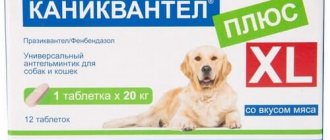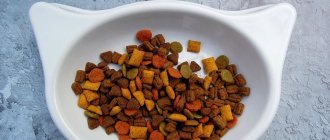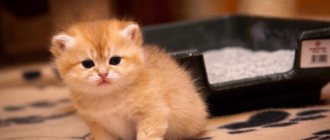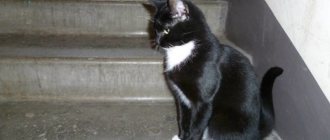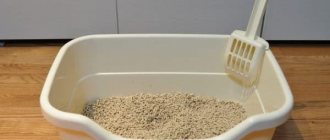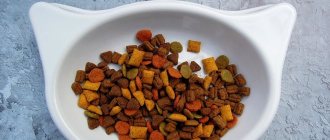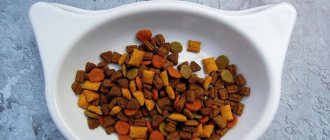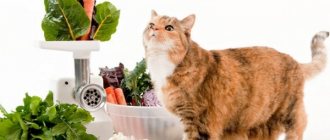Indications for use
Smecta has the same indications for children and adults. The drug can be given to babies from the age of one month.
The drug is taken for intestinal disorders, in particular diarrhea, caused by poor quality food or poor diet, as well as infectious diseases. In the latter case, Smecta is taken as part of a complex treatment.
The drug is effective for heartburn, discomfort and pain in the abdomen, bloating and other signs of dyspepsia, which indicate various diseases of the digestive system.
If a symptom of irritable bowel is detected, then the medicine will not be able to reduce diarrhea, but will significantly alleviate the condition by removing gases.
Purpose
Smecta is used as veterinary first aid for the first symptoms of gastrointestinal diseases, accompanied by vomiting and diarrhea. The drug is used as an enterosorbent for digestive disorders associated with poisoning from poor-quality food or a change in feed. The drug is safe for pets, including kittens.
The indication for prescribing Smecta as a medicine is diarrhea of various etiologies:
- with individual intolerance to certain foods;
- an excess of proteins in the diet (diarrhea is often accompanied by itchy skin and hair loss);
- transferring an animal from natural food to industrial feed and vice versa;
- transferring kittens after weaning from a cat to adult food;
- long-term treatment with antibiotics;
- infectious diseases.
Smecta will help against vomiting that accompanies infectious diseases or is caused by overeating (often in kittens that do not feel full), or the accumulation of hairballs in the gastrointestinal tract.
Important!
When vomiting, the composition of the vomit should be taken into account. If there is blood in them, you should immediately show your pet to a veterinarian, since this symptom indicates internal bleeding.
Causes of diarrhea in cats
Almost every owner has had to deal with intestinal upset in pets. Even a seemingly insignificant event such as moving to a new apartment can cause stress in cats, causing diarrhea. In small kittens, intestinal upset can be caused by overeating. After transferring a kitten to “adult” food, its body needs to readjust: to digest wet and dry food, different enzymes are needed than to digest mother’s milk. In addition, kittens do not feel full - they will eat until there is no food in the bowl.
Much more serious problems are caused by dangerous pathologies:
- poisoning;
- viral infections;
- imbalance of intestinal microflora - including after antibiotic therapy;
- helminthic infestations.
The biggest danger with prolonged diarrhea is the risk of dehydration. A large amount of fluid is washed out of the body with feces. A life-threatening condition occurs if the body loses 15-20% of water. Dehydration can cause the kidneys to fail, and then the pet will die. Therefore, it is important to consult a veterinarian for intestinal disorders and not self-medicate.
Important!
Prolonged diarrhea (more than 3 days) leads to weight loss, dehydration, loss of protein, and impaired tissue trophism. The result may be chronic renal failure, hypothermia, convulsions, and cerebral hypoxia.
Diarrhea may be accompanied by vomiting, and these are not always signs of poisoning. More often this is a systemic disorder, the causes of which can be different - from intestinal obstruction to oncology.
If you have diarrhea, you should pay attention to the color of the stool: it can indicate in which organ the pathology is developing:
- Unformed yellow stool may indicate diseases of the liver parenchyma. You should contact your veterinarian immediately;
- Green diarrhea can be observed due to putrefactive processes in the intestines, poisoning with low-quality feed, stale food;
- White feces are the most dangerous symptom of bile duct blockage and require immediate contact with a veterinarian.
Mucus in the stool is a sign of intestinal inflammation, an imbalance of beneficial and harmful bacteria in the gastrointestinal tract. It can be a sign of a deadly disease - viral peritonitis, and therefore requires complex treatment, and Smecta is used as a means of symptomatic therapy - to improve the condition of the animal.
Important!
Other dangerous viral diseases accompanied by diarrhea include enteritis and panleukopenia (feline distemper).
Diarrhea with blood is a reason to immediately contact a veterinary clinic. It may be a symptom:
- poisoning with pesticides, household chemicals;
- rectal trauma, intestinal rupture;
- acute pancreatitis;
- helminthic infestations (infection with coccidia, Giardia);
- viral diseases, in particular coronavirus, panleukopenia;
- oncology.
Reception by children
Smecta can be given to children from infancy. Often, babies have problems with the digestive system in the first days of life.
The instructions say that you can give the medicine from 4 weeks. The remedy can be given for malnutrition, which leads to abdominal pain and bloating, vomiting and diarrhea. Also effective for jaundice.
The optimal dose is determined only by a doctor. You need to dilute the powder in warm milk or water (50 ml), stirring until you get a homogeneous consistency. The specified volume must be divided into several doses.
For diarrhea
If a baby has diarrhea at the age of 1-12 months, then in the first 72 hours you need to give 2 sachets, after which you can give 1 sachet per day. Children from 1 year old can be given 4 sachets in the first 3 days, and after that - 2 sachets per day.
When vomiting
For vomiting in children under 1 year of age, give 1 sachet per day. A child over one year old can be given 3 sachets per day. If constipation occurs, the dose should be reduced.
Composition and action
The active substance of Smecta is diosmectite. This is a natural component, a mixed oxide of silicon and aluminum (or magnesium and aluminum silicate). Sodium saccharinate and dextrose promote better absorption of the medicine. The powder may have a citrus or vanilla flavor, but for animals it is better to choose a medicine without flavoring.
The general effect of diosmectite in both humans and animals is the adsorption of pathogenic microorganisms located in the gastrointestinal tract. It has the ability to bind toxins and infection-causing pathogenic microflora in the animal’s body. The mucous barrier is stabilized, the amount of mucus increases and its gastroprotective properties improve.
An important therapeutic effect of the drug is to protect the mucous membranes of the digestive tract from the negative effects of hydrochloric acid, bile, bacteria and their toxins, and various other aggressive factors. An additional protective layer of the mucous membranes of the gastrointestinal tract eliminates irritation and prevents further intoxication of the body.
Important!
The drug is absolutely safe for animals, however, it reduces the rate of absorption of other medications, so it is not recommended to give Smecta to a cat simultaneously with other medications.
Smecta during pregnancy
The drug is approved for use by pregnant women. There is no need to change the dose or diet. The components do not pose any threat to the developing fetus.
Most often, pregnant women take Smecta to combat heartburn, normalize the functioning of the digestive system, and prevent toxicosis.
If your doctor has not given any additional instructions, you can take 1 sachet 3 times a day.
The medicine can also be taken while breastfeeding; there is no need to adjust the dose or diet.
Dosage and method of administration
The experience of using Smecta in veterinary medicine shows that it effectively eliminates the symptoms of gastrointestinal disorders in almost all pets. Some of them become constipated. This is an adverse reaction that does not pose a threat to life and goes away on its own after reducing the amount of medication or stopping it.
When cats begin to have diarrhea or vomiting, they will usually refuse to eat. If fasting does not exceed 12 hours, then there is no danger. The body will gradually cleanse itself of toxins after using Smecta, and appetite will be restored. Prolonged refusal of water is a more serious threat. In such situations, the amount of water for preparing the suspension increases, and the pet must be forced to drink.
Some cats like Smecta and drink it with pleasure, especially since the volume of a single dose is very small. With vomiting and nausea, the smell of the suspension sometimes causes disgust in animals.
Treatment for diarrhea should begin immediately to prevent dehydration. Within 20 hours without assistance, the cat’s condition will deteriorate significantly, which will require more radical therapy.
The dosage for animals is prescribed by a veterinarian. If you can’t get to a specialist in the near future, then you should use the average standards:
- for adult cats – 1.5 g (half a sachet);
- for kittens – 0.6-1 g (1/4 or 1/3 of a sachet).
Instructions for use
For acute diarrhea in an adult, you need to drink no more than 6 sachets of powder per day. After you feel better, you can reduce the dose by half.
For other indications, the daily dose is 3 sachets.
Before taking, you need to dilute the solution in 100 ml of water to form a suspension. In case of inflammation of the mucous membrane of the digestive organs, you need to take the medicine after meals, in other cases 1 hour before meals or 2 hours after.
For diarrhea, the effect will be noticeable after 6-10 hours, for esophagitis - after 30-40 minutes, for poisoning - after 2-3 hours.
To consolidate the result, you need to continue taking the drug for 3-4 days.
Application in veterinary medicine
If your cat has diarrhea, you can give up to 5 ml 3 times a day. To prepare the suspension, mix half a sachet in 25 ml of water at room temperature. It is allowed to give 2 ml per 1 dose. The medicine must be drawn up with a syringe and gently squeezed into a place where there are no teeth.
If your dog has diarrhea, dissolve the powder in 10 ml of warm water. You can give 1 sachet three times a day.
If diarrhea does not stop, then the frequency of administration can be increased to 6 times a day.
When treating with Smecta, you need to introduce a diet. On the first day, it is better not to feed the animal at all.
Dosage
You can buy Smecta at any pharmacy. 1 sachet contains 3 g of powder for preparing a suspension. The dosage will depend on the age and weight of the pet. Kittens can be given enterosorbent from 1 month. To prepare the suspension, you need to take 0.5 sachet and 50 ml of water (for adult cats) or ¼ of the contents of a sachet and the same amount of water (for kittens). The solution must be mixed thoroughly until the powder is completely dissolved, then drawn into a syringe. It is more convenient to use small, 2-5 cc syringes.
You need to infuse the medicine after securing your pet with a towel or diaper. This way you can protect yourself from the cat’s sharp claws. For kittens, the volume of the finished medicine for one dose is 2 ml, for adults – 5 ml. You need to pour the solution into the mouth carefully, from the side, then lightly pinch the muzzle and mouth so that the cat cannot spit out the medicine. After 1-3 hours, the procedure should be repeated.
Important!
Taking Smecta does not relieve the owner of the need to take the cat to the veterinarian to determine the cause of the intestinal disorder.
Contraindications
Smecta has a minimal number of contraindications. The drug should not be used for:
- intestinal obstruction;
- severe sensitivity to constituent components;
- fructose intolerance:
- problems with the absorption of galactose and glucose.
You should avoid taking the medicine if you have osmotic diarrhea. It should be taken with caution in case of severe chronic constipation.
Price and analogues
Neosmectin is one of the analogues of Smecta.
The price of the drug Smecta varies depending on the region where it is purchased, as well as on the number of sachets in the box. 10 packages cost approximately 140-170 rubles.
The drug also has analogues with a similar therapeutic effect. The most in demand are the following:
- activated carbon is a sorbent that is prohibited from being used in the treatment of diarrhea in kittens (10 tablets cost 5-10 rubles);
- Neosmectin is a medicine that has the same price as Smecta, produced in Russia (about 200 rubles per package);
- Enterosgel is actively used in the treatment of gastrointestinal disorders in cats (medicine in a volume of 225 g costs between 400-600 rubles);
- Polysorb is prescribed for diarrhea caused by poor nutrition of the animal, poisoning (the price of the product varies between 200-350 rubles).
And in conclusion. The unique properties of Smecta to absorb everything unnecessary in the gastrointestinal tract and cleanse the body of toxins have made the drug popular not only in traditional medicine, but also in veterinary medicine. Cat breeders and specialists share on forums successful experiences in treating their pets for viruses, infections and simple diarrhea.
What it is
Smecta is a preparation based on the natural substance diosmectite - white clay.
It is a mixture of aluminum and magnesium. The supplier of unique raw materials for the medicine is a volcanic deposit from the Mediterranean island of Sardinia. Belongs to the group of effective sorbents. The mechanism of action is simple. The product enters the stomach, absorbs harmful microelements that cause the disorder.
Clears toxins and leaves the body undigested. Sold as a powder weighing 3 g.
Benefits of the medicine:
- It is not absorbed into the blood and does not accumulate in the body.
- It is located only in the gastrointestinal tract.
- Has a preventive effect.
- Has no side effects.
In what cases should Smecta be used?
You should give Smecta to a kitten against diarrhea only if you are sure that the diarrhea or stomach upset is caused by a sudden change in diet. In this case, the use of this drug is completely justified and quite effective. Otherwise, you first need to contact a veterinarian, because diarrhea can be a symptom of much more serious problems in the kitten’s body.
If we are talking about more severe malfunctions in the functioning of the kitten’s body , Smecta is usually used in conjunction with other medications. Therefore, knowledge of how and in what dosage to use the drug will be extremely useful for any pet owner.
© shutterstock
General information about Smecta
Smecta is a powder of a pleasant, creamy color with a sweetish odor and a uniform structure. The drug is packaged in sachets for single use. Once opened, the powder can be stored for no more than a day, since it absorbs moisture from the air and partially loses its medicinal properties. Since the drug is intended for humans, a dosage of 3 grams is incorrect for a kitten. To take Smecta, you need to dilute it in 100 ml of liquid and mix thoroughly. For a kitten, the suspension is given from a syringe without a needle, 0.5–1 cube.
Note! Officially, Smecta has no contraindications or side effects, but individual intolerance to excipients should always be kept in mind.
An acute reaction to Smecta is very rare, but if you suspect something is wrong, you should stop giving the drug and immediately consult a doctor.
How to use Enterodes
An analogue of “Smecta” is “Enterodes”. This is an enterosorbent agent, which is a powder for oral administration. Indications for its use are: toxic damage to the digestive tract by infectious pathogens, endogenous intoxication due to renal and liver failure, exacerbation of chronic enteritis and enterocolitis. One sachet of Enterodeza is diluted in 100 ml of cold boiled water. Children are allowed to add sugar or fruit juice to the solution. Adults are prescribed 100 milliliters of the drug solution from one to 3 times a day. For children over the age of one year, Enterodes is given at the rate of 0.3 g/kg/day. Children aged one to three years are prescribed 50 ml of the drug twice a day, from four to six years - 50 ml three times a day, children aged seven to ten years - 100 ml twice a day, from eleven to fourteen years old – 100 ml three times a day. The course of taking the drug will depend on the severity of the symptoms and can last from 2 to seven days. “Enterodesis” rarely causes side effects, these include vomiting, nausea, and allergic reactions.
If the doctor has prescribed your patient treatment for diarrhea, most likely Smecta will be the main therapeutic agent. How to properly give Smecta to a kitten and is the drug harmless for the baby? How to calculate the dosage and is it worth using a human drug when treating a quadruped? If you have any of these or similar questions, you will get all the answers below.
Every kitten's digestive system faces two major tests. The fact is that a baby is born with a sterile microflora and one of its main tasks is to travel to the mother’s nipple.
As the kitten takes its first sips of rich colostrum, it ingests bacteria that colonize its intestines and help digest its mother's milk. After giving birth, the cat feeds the kittens colostrum for 1–3 days, after which its composition changes.
When the baby turns 1 month old, his digestive system faces a new test - getting used to adult food. Regardless of whether the mother of the kittens eats natural or industrial food, this food is new for the kittens, one might say, unnatural. The microflora intended for digesting milk begins to be partially replaced, and the intestines become irritated. The kitten begins to have looser stools or diarrhea, indicating that the intestines are protecting themselves by producing more mucus. If the kitten is healthy, then in 2 months (plus or minus a week) its digestion will return to normal.
There is also a risk. Diarrhea quickly leads to dehydration
, and when it comes to a kitten, the period is reduced to 20–30 hours. If the cause of diarrhea is not a change in diet, and the baby is not helped, then his condition will greatly worsen. Dehydration leads to blood thickening, which has a detrimental effect on all vital systems.
Can cats have Smecta?
Considering the safe properties of the drug, the answer is definitely yes. But you need to calculate the dosage correctly.
Smecta for cats is used in the following dosages:
- For kittens (up to 5 months) 0.3-0.5 ml is enough. suspensions.
- Young cats (up to 1.5 years) – ten times more (3-5 ml.).
- For the rest - a little more (6 ml.).
To achieve a positive result, take it 3-4 times a day.
The powder is diluted in cooled boiled water until it becomes pasty or liquid. It all depends on in what form it is easier for your pet to consume it.
Veterinarians themselves recommend this sorbent for diarrhea and vomiting in animals. Reviews about the use of Smecta by cats are only good. It is extremely rare that there is no positive effect from the medicine. Except that owners often note a negative reaction from their pet.
Mechanism of action of the drug
"Smecta" has an absorbent effect on the body. The active substance collects toxins and harmful microorganisms found in the intestines and is excreted unchanged along with feces or urine. In addition, the components of the drug come into contact with glycoproteins of mucous tissues and form polyvalent bonds, creating a natural barrier to hydrochloric acid, bile salts and waste products of harmful bacteria.
When to start treating your pet
Indications for use of Smecta for cats or cubs are identical - any disorders of the gastrointestinal tract. This can be either a slight bloating of the tummy, which is often found in small pets when transitioning from breastfeeding to solid food, or full-blown diarrhea. If the disorder is prolonged and taking Smecta does not bring the expected result , it is more advisable to show the cat to a qualified specialist and continue treatment under the strict supervision of a veterinarian.
Particular attention should be paid to kittens when loose stools appear. When switching to adult food for a small animal, this phenomenon is considered quite normal and does not cause any particular harm to the body. The main thing is to prevent dehydration at such a moment. It can occur literally in 20 hours. It is also important not to miss other diseases. After all, the cause of diarrhea can be not only a change in food, but if you do not provide the furry little one with proper medical care in a timely manner, it will become much worse.
© shutterstock
Chemical composition
“Smecta” goes on sale with orange and vanilla flavors. The main active element of the drug is diosmectite.
The number of additional elements in them will differ:
| Orange "Smecta" | Vanilla "Smecta" |
| orange flavoring – 0.01 g | vanillin - 0.004 g |
| vanilla flavoring - 0.05 g | dextrose monohydrate - 0.749 g |
| dextrose monohydrate - 0.679 g | sodium saccharinate - 0.007 g |
| sodium saccharinate - 0.021 |
What can cause a kitten to have diarrhea?
The most common cause of diarrhea in kittens and adult cats is a change in diet. When an animal eats the same food for a long time, the body develops an addiction, and if this “habit” is broken, the intestines can react with various malfunctions. In the case of kittens, the cause of diarrhea may be the transition from mother's milk to regular food. Intestinal problems can also arise from cow's milk or excessively fatty foods.
Sometimes the cause of diarrhea can be various diseases and disorders in the body. That is why, if a kitten has problems with stool, you should in any case consult a specialist, since self-medication can remove the symptoms, but not solve the problem as a whole. The use of Smecta for diarrhea in kittens is, rather, an emergency measure that will quickly improve the baby’s condition.
Side effects
With long-term use of Smecta in cats, the process of defecation may be disrupted and constipation may occur. The situation is corrected by reducing the dose.
Other possible side effects from long-term use:
- bloating, nausea, vomiting;
- impaired absorption of nutrients: vitamins, microelements.
It is also possible that individual intolerance or allergic reactions to additives in the composition may occur. Therefore, before giving Smecta in full dosage, you need to test it on a small amount of the medicine. If the animal feels well, continue treatment.
Analogs
Enterosorbents are of several types based on their chemical structure (carbon, based on natural, synthetic resins, dietary fiber, silicon-containing). Smecta is a natural silicon-containing sorbent.
Analogues from the natural group:
- Polysorb;
- Kaolin (white clay);
- Neosmectin.
Synthetic analogues:
- Enterosgel;
- Enterodesis;
- Enterosorb.
Studies have shown that the power of Smecta as a sorbent is higher than that of Polysorb and Enterosgel. Smectite, due to its enveloping ability and fluidity, covers a significant surface of the intestinal mucosa.
The advantage of Smecta among other sorbents is also its complex action. The main component of the product absorbs gases, undigested carbohydrates, bile acids, bacteria, rotaviruses.
Why kittens and adult cats may develop diarrhea
Digestive disorders can occur even in completely healthy cats. Most often it occurs when changing food. For kittens who switch from mother's milk to regular food, and for adult cats who are forced to change the nature of their food, a period of adaptation is inevitable, which proceeds in different ways, but sometimes causes undesirable consequences in the form of diarrhea.
There is a list of foods that cannot be given - cats simply do not digest them. Not all owners comply with the ban. Sometimes the furry extortionists get a piece from the table or cow's milk.
Is it worth giving Smecta to a kitten?
Transferring a pet to adult food is in most cases accompanied by diarrhea, so when introducing complementary foods, you can give the kitten “Smecta” for preventive purposes. In this case, the diarrhea goes away within 5 hours. If there is any doubt that diarrhea could be caused not by a change in food, but by some other reason, you should definitely show your pet to a doctor, because compared to an adult cat, the risk of death from dehydration in a pet is much higher.
When a baby is poisoned or eats spoiled food, there is no need to stop diarrhea and vomiting - in this way the body cleanses itself of poisons.
How to administer the solution to a cat
The animal, of course, is unaware of the benefits of Smecta. Therefore, he will not drink it voluntarily. It is useless to mix with food. The body gets rid of powder and food faster than necessary.
It is better to carry out the treatment process with someone in pairs. One holds the patient tightly (you can wrap him in a sheet, towel, scarf, etc.), the other tries to inject the dose. Just don't squeeze the cat. Her stomach already hurts. The syringe is inserted into the mouth, under the root of the tongue on the side. In this position, the patient will not be able to spit out the medicine.
If the cat wants to drink after this, do not interfere. There will definitely be no harm from water.
After the procedure, we observe the animal. If everything is in order, then after 2 hours we repeat again. A lasting improvement should occur in about 8-9 hours.

